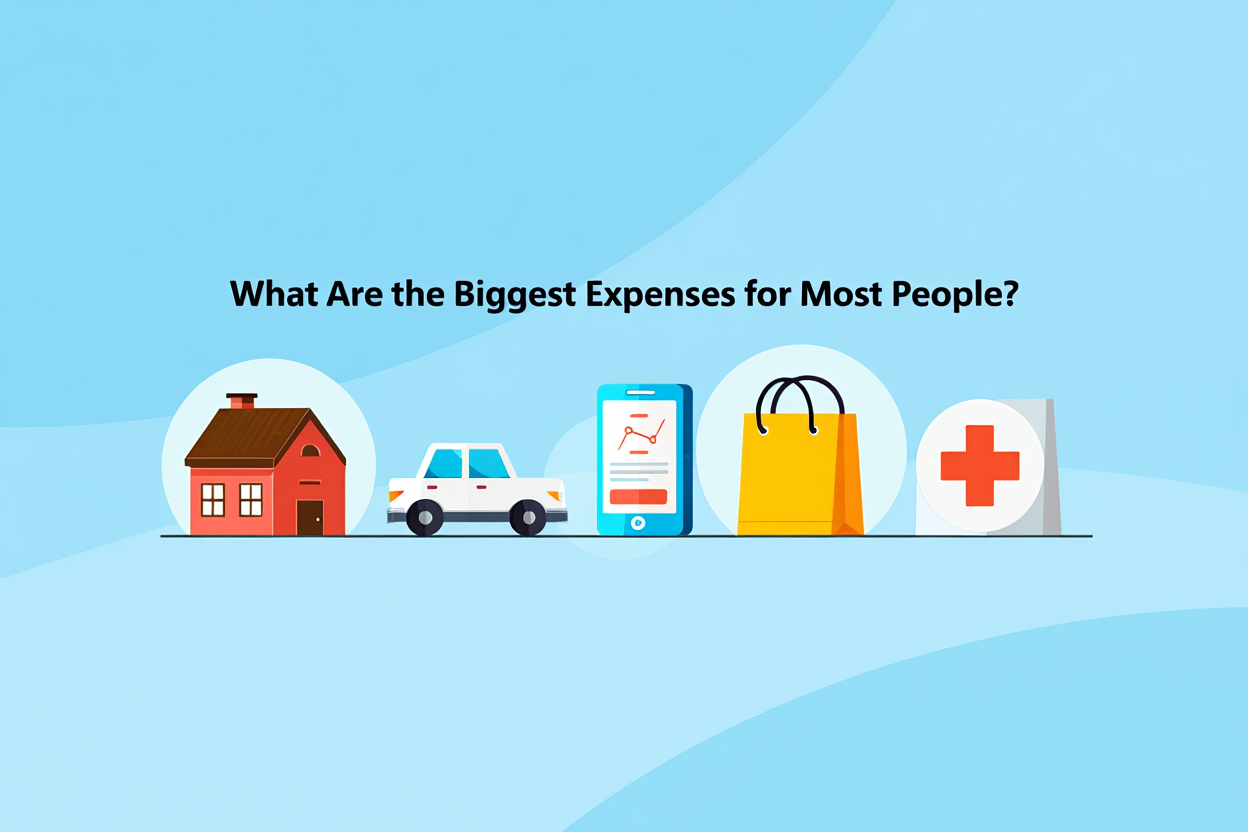
Managing your finances starts with understanding where your money goes. If you’ve ever wondered, “What are the biggest expenses for most people?” — you’re not alone.
In this guide, we’ll break down the major categories that eat up your income, backed by real statistics, and share practical tips to help you cut costs and save more.
By the end, you’ll have a clear picture of your spending habits — and a roadmap for taking control of your money.
Quick Overview: Biggest Expenses for the Average Person
Infographic Suggestion:
(A pie chart showing percentage breakdowns: Housing, Transportation, Food, Insurance, Healthcare, Debt, Entertainment, Savings)
| Expense Category | % of Average Income |
|---|---|
| Housing | 30-35% |
| Transportation | 15-20% |
| Food | 10-15% |
| Insurance (Health, Car, Life) | 10-15% |
| Healthcare | 5-10% |
| Debt (Loans, Credit Cards) | 5-10% |
| Entertainment & Lifestyle | 5-8% |
| Savings & Investments | 5-10% |
1. Housing Costs: The #1 Biggest Expense
When it comes to where your money goes, nothing swallows up a paycheck faster than housing.
Whether you rent or own, housing often takes 30–35% of an individual’s or family’s income.
Common Housing Costs:
- Rent or mortgage payments
- Property taxes
- Home insurance
- Utilities (electricity, water, gas)
- Maintenance and repairs
- HOA fees (Homeowners Association fees)
Fun Fact: According to the U.S. Bureau of Labor Statistics (BLS), the average American household spent $24,298 on housing in 2023.
Ways to Reduce Housing Expenses:
- Downsize to a smaller home or apartment
- Move to a lower-cost-of-living area
- Get a roommate to share costs
- Refinance your mortgage when interest rates are low
- Invest in energy-efficient appliances to lower utility bills
2. Transportation: A Close Second
Getting from point A to point B isn’t cheap. After housing, transportation ranks as the second-biggest expense for most people.
Common Transportation Costs:
- Car payments
- Auto insurance
- Fuel (gasoline or electricity)
- Maintenance and repairs
- Public transportation (bus, train, subway fares)
- Rideshare services (Uber, Lyft)
On average: Americans spend $10,961 annually on transportation (BLS 2023).
How to Save on Transportation:
- Drive a fuel-efficient or electric vehicle
- Carpool or use public transportation
- Walk or bike when possible
- Shop around for cheaper car insurance
- Avoid unnecessary trips by planning errands together
3. Food: Essential, Yet Expensive
Everyone needs to eat — but food spending can spiral quickly if you’re not careful.
Groceries, takeout, restaurants, coffee shops — it all adds up.
Food Expense Breakdown:
- Groceries: Fresh produce, meats, canned goods, snacks
- Dining out: Restaurants, fast food, coffee, delivery apps
- Meal subscriptions or meal prep services
Average spent on food: About $8,289 per year per household (BLS 2023).
Pro Tips to Cut Food Costs:
- Meal plan and grocery shop with a list
- Buy in bulk for non-perishable items
- Cook at home instead of dining out
- Use apps for coupons and cashback rewards
- Grow a small herb or vegetable garden
4. Insurance: Health, Auto, Home, Life
Insurance premiums can quietly drain your income. Most people pay for multiple types of insurance to protect themselves against unexpected events.
Typical Insurance Costs:
- Health insurance premiums
- Auto insurance premiums
- Life insurance premiums
- Homeowners or renters insurance
- Disability or long-term care insurance
The numbers: Health insurance alone can cost $5,588 per year for an individual, and $15,186 for a family (KFF 2023 report).
How to Lower Insurance Costs:
- Bundle insurance policies (e.g., auto + home)
- Shop around for better quotes annually
- Increase deductibles for lower monthly premiums
- Take advantage of employer-sponsored plans
- Live a healthy lifestyle for better rates (especially for life insurance)
5. Healthcare: Beyond Insurance
Even if you have insurance, out-of-pocket healthcare expenses can be substantial.
Co-pays, deductibles, prescriptions, and non-covered services add up.
Healthcare Costs Include:
- Doctor’s visits and specialist appointments
- Prescription medications
- Dental care and vision care
- Medical devices (e.g., glasses, hearing aids)
- Therapy or mental health services
Average healthcare spending: Around $5,850 per household annually.
Tips to Manage Healthcare Costs:
- Use Health Savings Accounts (HSAs) or Flexible Spending Accounts (FSAs)
- Stay in-network for doctor visits
- Shop for generic medications
- Get preventive care (like free annual checkups)
6. Debt Payments: Student Loans, Credit Cards, Personal Loans
Debt payments can severely limit your financial flexibility if not managed carefully.
Types of Debt:
- Student loans
- Credit card balances
- Personal loans
- Auto loans
- Payday loans
Debt in numbers: The average American carries about $6,365 in credit card debt (Experian 2023).
Strategies to Reduce Debt:
- Pay more than the minimum payments
- Use the snowball or avalanche method
- Consolidate high-interest debt
- Avoid new debt unless necessary
- Build an emergency fund to prevent future debt
7. Entertainment & Lifestyle
Entertainment is crucial for mental health — but it’s also a common budget buster.
Lifestyle Expenses:
- Streaming services (Netflix, Spotify, Disney+)
- Gym memberships
- Travel and vacations
- Hobbies and leisure activities
- Subscriptions and apps
Average spent: Households spend around $3,458 per year on entertainment (BLS 2023).
How to Enjoy Life Without Overspending:
- Set a monthly “fun budget”
- Use free or low-cost entertainment options
- Share streaming services with family
- Prioritize experiences over expensive goods
- Take advantage of local parks and community events
8. Savings and Investments
Ideally, savings and investments should be a “planned expense,” not an afterthought.
Unfortunately, many people save what’s left over — which often isn’t much.
Types of Savings:
- Emergency fund
- Retirement accounts (401(k), IRA)
- College savings (529 plan)
- General investing (stocks, ETFs, real estate)
Recommended: Save at least 20% of your income, following the 50/30/20 budgeting rule.
How to Boost Savings:
- Automate your savings
- Set specific financial goals
- Take advantage of employer 401(k) matches
- Invest early to maximize compound interest
Full Expense Breakdown Example:
[Infographic Suggestion:] Personal Monthly Budget Sample
| Expense Type | Monthly Amount | % of Income |
|---|---|---|
| Housing | $1,500 | 30% |
| Transportation | $600 | 12% |
| Food | $450 | 9% |
| Insurance | $400 | 8% |
| Healthcare | $250 | 5% |
| Debt Payments | $300 | 6% |
| Entertainment | $200 | 4% |
| Savings/Investments | $800 | 16% |
| Miscellaneous | $500 | 10% |
Final Thoughts: Knowing Your Biggest Expenses is Key to Financial Freedom
Now that you know what the biggest expenses are for most people, you’re one step closer to mastering your money.
By tracking your spending, setting a realistic budget, and identifying opportunities to cut costs, you can take control of your financial future.
Remember, the goal isn’t just to save money — it’s to spend intentionally on the things that truly matter to you.
FAQ: Biggest Expenses
Q: What expense category is the hardest to control?
A: Housing is often the hardest because it’s a fixed cost and moving isn’t always easy.
Q: Should I focus more on cutting small daily expenses or big fixed costs?
A: Focus on reducing big fixed expenses first — it has the greatest long-term impact.
Q: How much should I spend on housing?
A: Financial experts recommend spending no more than 30% of your gross monthly income on housing.
👉 Shop Budget Trackers Now
Take the first step toward smarter, simpler money management today!


